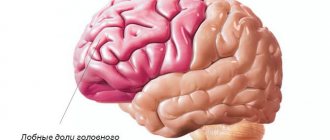CATAR'S SYNDROME
(J. Cotard, French psychiatrist, 1840-1887; synonym:
melancholic paraphrenia, melancholic delusion of imagination, megalomelancholic delirium
) - one of the stages in the development of anxious-agitated depression, accompanied by hypochondriacal-depressive delusions of denial and enormity, extending to moral and physical properties of an individual, various phenomena of the surrounding world, or all at the same time.
The combination of psychopathol, disorders that form K. s., the features of their occurrence and development during the disease were first described by Cotard in the 80s. 19th century In 1892, at the congress of the French. psychiatrists in Blois, the symptom complex of mental disorders identified by Cotard was called Cotard's syndrome. Until the middle of the 20th century. The main studies specifically devoted to K. s. belonged exclusively to the French. psychiatrists. The development of the clinic of psychoses in the elderly, primarily involutional melancholy (see Presenile psychoses), schizophrenia (see), manic-depressive psychosis (see), carried out by domestic psychiatrists in the 2nd half of the 20th century, made it possible to supplement the doctrine of K . With. new facts. In him. In psychiatry, the totality of disorders that make up K.'s village has not been specifically studied. A number of them researchers designate individual manifestations of K. s. the term "nihilistic delirium".
Among elderly patients with depressive psychoses, disorders included in K. s. are noted in 10-25% of cases. In women K. s. occurs much more often than in men.
Causes
The etiopathogenetic factors of the disease are currently not fully understood. One of the modern theories states that the causes of Cotard's syndrome are brain abnormalities, namely dysfunction of the frontotemporo-parietal neuronal circuits.
Possible causes of Cotard's syndrome:
- severe depression
- long-term use of large doses of antidepressants,
- previous operations,
- prolonged psycho-emotional stress, chronic stress, irritability are factors that eventually lead to the development of the syndrome.
Cotard's syndrome has not been identified as a separate nosology. It is a manifestation of various mental illnesses.
Pathologies manifested by Cotard's syndrome:
- schizoid disorders,
- dementia,
- depression,
- seizures,
- brain tumors,
- multiple sclerosis,
- TBI,
- progressive paralysis,
- atherosclerotic damage to the blood vessels of the brain,
- psychoses,
- infectious diseases - typhoid fever,
- melancholy,
- amnesia,
- severe intoxication,
- metabolic disorders.
Chronic stress leads to fatigue, tiredness, isolation, a persistent reluctance to see anyone, dissatisfaction with oneself, self-doubt, hopelessness, headaches, insomnia, exacerbation of skin problems, loss of interest in sexual life, cravings for alcoholic beverages and psychotropic substances. Severe depression and complete indifference to everything around develops. Outwardly, patients resemble dead people from horror films. Mentally ill people have a lower pain threshold. They are constantly haunted by pathological anxiety and feelings of guilt. Patients' behavior becomes aggressive over time. They do not take care of themselves, do not eat or drink. If patients do not commit suicide, they die from hunger and exhaustion.
Clinic
The first clinical sign of the disease is a feeling of anxiety. Some patients think that they are dead, others, on the contrary, feel their immortality. They are ridiculously delusional about their body size.
Thanks to statements about their own non-existence, their pain sensations decrease. By causing pain and harm to themselves, they are trying to prove that their bodies do not live, they are huge, but dead, there is no blood in their vessels. Patients often hear voices that direct their actions and destroy them. The patient is the greatest criminal who infected everyone around him with deadly infections and incurable diseases, became the cause of child mortality and the culprit of all wars. For this he will be severely punished.
Patients believe in the rotting and disintegration of the body, experience severe anxiety, do not make contact well, look for a catch in everything, and do not trust anyone.
- A mild degree is manifested by an inexplicable feeling of guilt and anxiety. Depending on the severity of the etiological factors, this form can last several years or reach full development in one to two weeks. Patients acquire a negative attitude, become gloomy and irritable.
- The average degree of Cotard's syndrome is manifested by the patient's disgust and hatred of himself, a tendency towards masochism, and a desire to harm himself or commit suicide. Patients inflict bodily harm on themselves, thereby trying to punish themselves for their miserable existence.
- A severe degree develops in the case of significant pathological changes in the central nervous system of patients. They plunge into the world of the dead, often visit the cemetery, and “talk” with the dead. Mentally they maintain a certain connection with the dead. Patients become extremely anxious, experience mental anguish, become depressed, and often commit suicide. The thought of the absence of life on the planet drives them crazy. At this stage, delusions and hallucinations appear.
Cotard's syndrome can occur in a mild form, in which a number of symptoms are absent. The pathology can have a fulminant or episodic course.
Main symptoms of the disease:
- Megalomania is the awareness of oneself as someone special: an alien destined to destroy all life, a destroyer or savior of the world, a being created to accomplish great things.
- Hypertrophied nihilism - the patient’s life has no meaning, thoughts of the absence of internal organs, refusal of food, water and treatment.
- Depression - increased anxiety, concern, nervousness, constant vigilance, suicide attempts, hypochondriacal state, immortality. Patients commit desperate acts, inflicting mortal wounds on themselves.
- Hallucinations - olfactory, auditory, visual. Patients smell an unpleasant odor from their bodies, see monsters, and hear orders about upcoming tests.
- Motor manifestations include wringing of hands, twisting of hair and clothes, constant walking from side to side, incoherent flow of words.
Cotard's syndrome is a multisymptomatic disease that develops gradually, has a complex and severe course, requiring others to have a special attitude towards the patient.
Video: patient with Cotard's syndrome
Clinical picture
Despite the fact that manifestations of K. s. are observed with various nosoles. forms, it has a number of common features both in symptomatology and in the features of its development. It can always identify intense affective disorders, which are characterized by either depression with severe anxiety or depression with fear. A common disorder is melancholic depersonalization (see), often in the form of anaesthesia dolorosa psychica, less often in the form of the so-called. loss of mental vision, when patients become unable to imagine familiar faces, furnishings, and past life events, accompanied by a painful feeling of mental emptiness. Depression in K. s. always combined with agitation of various degrees - from simple wringing of the fingers to states of frantic motor excitement, including in the form of melancholic raptus (frantically melancholy excitement with a feeling of despair). Agitation is often accompanied by speech excitation, usually in the form of anxious verbalization (see Depressive syndromes). At the height of motor excitation, episodes of depressive substupor or stupor may occur (see Stuporous states). Thus, with K. s., as a rule, mixed states of various manifestations are noted, which are “the preferred affective background on which K. s. arises.” Sensory disorders are most often represented by verbal illusions (see), often in the form of illusory hallucinosis, less often auditory hallucinations and mental automatisms, primarily ideational - mentism (involuntary rapid flow of thoughts, accompanied by figurative ideas and a feeling of vague anxiety), unwinding of memories, auditory and visual pseudohallucinations (see Kandinsky-Clerambault syndrome). In some cases, with K. s. clouding of consciousness occurs, usually in the form of oneiroid (see Oneiric syndrome).
Against the background of the listed disorders, fantastic delusions arise, the main signs of which are denial and enormity. Denials can be partial, most often relating to moral, intellectual or physical. properties of the patient (“no feelings, conscience, compassion, knowledge, ability to think; no stomach, intestines, lungs, heart, bladder”), or they may speak not about the absence, but about the destruction of internal organs (“the brain has dried out, the lungs have shrunk, the intestines are clogged"). Ideas of denial concerning the physical self are usually defined as hypochondriacal-nihilistic or simply nihilistic delusions. In a number of cases, personal categories are denied (“no name, age, education, profession, family, never lived”). Denial can be generalized, extending to various concepts of the external world, which may be dead, destroyed, lose their inherent qualities, or be absent altogether (“the whole world is dead, the planet has cooled down, nothing grows on it, there is no one in the world, there are no whites, black, Europe, Africa, winter, spring, stars, years, centuries"). The patient may believe that he is alone in the entire universe and may deny the existence of everything (“there is nothing”).
Along with the delusions of denial and enormity, it is often possible to identify delusions of self-blame that are fantastic in content (patients consider themselves to be the root cause of the world cataclysms that have occurred; attribute incredible crimes to themselves; call themselves monsters, reptiles, monsters; often correlate their actions with those committed by mythical or historical characters, they call themselves the Antichrist, Cain, Judas, Hitler; they talk about deserved punishments, sometimes listing the most incredible ways of paying for their deeds). In a number of cases, the fantastic delirium of self-accusation takes on a retrospective character. At the same time, patients can talk about impending eternal torment or the impossibility of dying, either in general or as a well-deserved retribution. The inability to die and eternal torment, according to patients, can be realized even when their physical self disappears - “the body will be burned, but the spirit will remain forever - tormented.”
It is possible to combine the ideas of immortality with the delirium of metamorphosis - transformation into an animal, into a corpse, into metal, wood or stone. A distinctive feature of delusional statements of patients with K. s. is the presence in them of distinct elements of imagery and clarity. Often patients themselves pay attention to this (“every spoken word grows in the mind into something big; fantasy turns a fact into a whole story; imagination draws entire scenes, a word grows into a thousand words and a picture appears”). The peculiarities of the delusion of self-blame and its verbal expression gave rise to such synonyms of KS as “megalomelancholic delirium,” “melancholic paraphrenia,” and “melancholic delirium of the imagination.”
The combination of delirium of denial and the enormity of hypochondriacal-nihilistic and depressive content characterizes the full or expanded K. s. If any one of these components predominates, they speak of the corresponding variants of CS—nihilistic or depressive. They occur much more often than expanded K. s. In addition to these two options, there are types of K. s., based both on symptomatology and on the characteristics of the course of K. s. Segla (JE Seglas, 1897) identified: 1) typical cases, that is, those in which all the components of K. were present; 2) erased cases - with the absence of a number of symptoms, for example, ideas of doom to eternal torment, ideas of immortality, etc.; 3) cases with a very rapid appearance of all symptoms forming K. s.; 4) cases with similar development of only part of the symptoms; 5) cases where the symptoms that form K. pages occur in the form of episodes.
The most characteristic stereotype of the development of depression, during which K. develops. (regardless of their nosole, affiliation and characteristics of the course - paroxysmal or chronic), the following sequence of occurrence of stages of mental disorders is the following: the stage of anxious depression without ideomotor inhibition; stage of anxious-agitated depression with delusional ideas of self-blame, self-humiliation, accusations, melancholic depersonalization, verbal illusions and other sensory disorders; the occurrence of symptoms that together form K. s.
The use of electroconvulsive therapy (see) and especially psychotropic drugs for the treatment of depressive psychoses had a significant impact on the wedge, K.'s manifestations. His detailed paintings began to appear less frequently, and depressive and nihilistic versions of K. s. are more often manifested by reduced symptoms. Patients talk, for example, about their unusual guilt, but in general, without any specific facts, and also without identifying themselves with anyone; There may be thoughts about the impossibility of dying, but they are not accompanied by the conviction of immortality and doom to eternal torment. Instead of generalized ideas of denial or destruction of internal organs, only statements about the non-functioning of gland.-kish are more common. tract or respiratory organs. In some cases, statements characteristic of K. s. are not nonsense, but obsessive phenomena of fantastic content, with which the patient is trying to fight. If, before the introduction of active therapy methods, the presence of K. s. spoke about hron, depression, now cases that occur in attacks dominate.
Diagnostics
Diagnosis of Cotard's syndrome is based on the clinical symptoms of the pathology. Psychiatrists diagnose and treat the disease. They talk with the sick person and his loved ones. If necessary, instrumental methods are used - CT and MRI to determine the anatomical and physiological features of the brain.
Difficulties in diagnosis are explained by the reluctance of patients to seek medical help. In their opinion, visits to specialists are pointless and impractical. They assure that treatment will not help the corpse. Only close people can notice in time the changes occurring in the patient’s behavior and take him to the doctor. Patients often get an appointment with a specialist too late.
Ganser syndrome
This syndrome is reminiscent of Munchausen syndrome, since a person’s internal anxiety is transformed into demonstrative, defiant, inappropriate behavior that is directed at others. Another name for it is hysterical psychosis. It was first described by the German psychiatrist Ganser in a person who was under investigation. The disorder is still more common when something threatens a person’s social status—for example, a trial. But this could be mobilization into the active army, or even a sudden break in relations.
With this syndrome, a person behaves like a child - sits on the floor, “plays” with surrounding objects. Answers simple questions incorrectly (for example, confuses left and right), cannot get dressed, forgets how to eat. What’s strange is that a person understands speech addressed to him, but says or does everything as if “by.”
Sometimes it gets to the point of “running wild” - a person gets on all fours, laps up water from a bowl, barks, howls and tries to bite people around him.
After an attack, a person does not remember what happened to him. This syndrome is incredibly rare. It is almost never mentioned in movies or feature films. On the other hand, maybe we just have a bad idea of what happens to a person facing prison.
Treatment
Treatment of Cotard syndrome is carried out in a neuropsychiatric hospital under the supervision of medical personnel. Only a specialist in psychiatry will be able to correctly select medications to restore mental health.
Drug treatment of Cotard's syndrome is aimed at eliminating the source of delirium. It consists of the use of the following groups of drugs:
- antidepressants – “Amitriptyline”, “Fevarin”, “Melipramine”;
- antipsychotics - “Rispolept”, “Ariprizol”, “Aminazin”, “Tizercin”;
- anxiolytics – “Grandaxin”, “Afobazol”,
- tranquilizers – “Phenazepam”, “Amizil”.
Electroconvulsive therapy is a method of applying low-intensity direct electric current to brain structures in order to achieve a therapeutic effect. Electroconvulsive treatment is currently a worthy alternative to psychopharmacotherapy. Indications for its implementation are psychoneurological diseases for which other treatment methods have proven ineffective. Due to its high efficiency and speed of onset of effect, electroconvulsive therapy is used as an emergency treatment.
During psychotherapeutic sessions, pathology is fought. This requires an individual approach to the patient and optimal contact with him. Trust must be established between doctor and patient. Rational psychotherapy is based on suggestion.
To achieve maximum effect, drug therapy should be combined with electroconvulsive treatment and psychotherapy. If these recommendations are neglected and not treated, the patient will sooner or later turn into an inanimate object.
History of the name of the disease
In 1880, French doctor Jules Cotard was visited by a woman known to posterity as “Mademoiselle X.” She complained of anxiety, despair and a more serious symptom: she believed she was dead. She claimed that "she has no brain, no nerves, no breasts, no stomach, no intestines... just the skin and bones of a decaying body." Despite this predicament, she also believed that she was "eternal and will live forever."
Cotard called her mysterious illness "delirium of denial" and set out to document one of the rarest diseases known to mankind, called Cotard's syndrome or "walking corpse syndrome." Mademoiselle X is not alone in her experiences, although only a few actual documented cases have been found since 1880. Part of the problem is that Cotard syndrome is often diagnosed as another mental disorder, such as schizophrenia, a condition that often co-occurs.
Prevention
To avoid developing Cotard's syndrome, you need to monitor your emotional state. Nervous strain and frequent stress lead to the development of depression with signs of suicide. It is necessary to remain calm and control yourself in any situation.
When the first symptoms appear, you should seek help from qualified specialists. Your favorite hobby, yoga, good music, massage, a bath with aromatic oils will help you relieve moral stress on your own. If these methods do not help, then it’s time to use mild sedatives.
Expert recommendations:
- avoid stress and head injuries,
- avoid depression and psychosis,
- eat right,
- play sports
- toughen up,
- walk a lot in the fresh air,
- try to find beauty in the ordinary.











